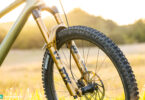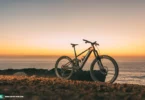Which is the best e-mountainbike of 2024? To find out, we pitted 27 of the most exciting bikes of the year against each other in our huge e-mountainbike comparison test. It was a hard-fought race, but in the end we emerged with a strong winner, a clear loser and a comprehensive, in-depth overview of the market. But which bike will suit you and your individual requirements best?

Table of contents
- What should the best e-mountainbike of 2024 be capable of?
- What type of ebiker are you?
- Our huge e-mountainbike test field: 27 of the most exciting e-mountainbikes currently available on the market
- The motor systems in our 2024 e-mountainbike group test: which motor concept suits you best?
- Where and how did we test the bikes?
- Our e-mountainbike comparison test in numbers
- What should you look for when buying an e-mountainbike?
- Tops and flops from our 2024 e-mountainbike group test
- An overview of all the e-mountainbikes in our 2024 comparison test
- Our Best Buy Tip: the 2024 Canyon Strive:ON CFR LTD
- The best e-mountainbike of 2024: the 2024 Orbea WILD M-LTD
- Exciting recommendations from our test field
Can you think of anything more frustrating than spending all your savings on the wrong bike? But it looked great and seemed like a real bargain… Well, unfortunately, that’s only half of the story! What really matters is that you have fun cruising down your dream trail, which is why you need a bike that best suits your very own needs and requirements – a two-wheeled glove! However, what makes the difference between happiness and frustration isn’t the price of a bike, but rather its character, qualities and features – but more on this later. How do you work out which bike and concept suit you best? Simple: by seeking advice before buying your new eMTB – everyone needs it, whether you’re a beginner or a pro.
The current e-mountainbike market is flooded with new products, categories and supposed innovations. However, the promises are often misleading, with the reality looking completely different from what you’d expect – as we found out the hard way during this test!


To help you make the right choice with your next e-mountainbike, we packed 27 of the most exciting e-mountainbikes of the year into the back of our van and hit the road, heading south in search of warm weather and dry trails. Sunny Spain was our destination. Here we spent two weeks testing, discussing, and analysing the character and behaviour of the bikes on a set test track. Our big test team rode the bikes over and over, back to back, comparing them against each other, and did more of the same when we got back to Germany, putting the entire test field through the wringer once more on our home trails around Stuttgart. After weeks of relentless testing, we can provide you with an in-depth market overview of the most important e-mountainbikes of 2024, with all of the crucial information, some exciting insights and thorough buying advice. We’ll tell you what to look out for when buying your next bike, what makes a good eMTB, and which e-bike suits your rider type best. You’ll also get a better idea of why there’s no point in just buying the most expensive, fancy looking e-mountainbike you can find, without first understanding whether it suits you or not.


What should the best e-mountainbike of 2024 be capable of?
Our readers played a crucial role in our search for the best e-mountainbike of 2024! After all, who better than 14,000 passionate eMTBers to tell us what they expect from a modern eMTB? Coincidentally, that’s just how many readers took part in our 2023 reader survey, answering up to 80 (!) questions in what we consider to be the most representative survey in the e-mountainbike world.
Since e-mountainbikes are expected to cover many different applications, we weren’t looking for a specialist that excels at just one discipline, but rather for the most versatile bike that proves the perfect all-rounder. In our search for the best, it was crucial for us not to use a rigid scoring system in which individual parameters are viewed and compared in isolation, but rather to focus on the consistency of the overall concept. What’s the point in splashing out millions on a supercharged supercar if the tires lack grip and can’t transfer all of that power to the road? It’s like a delicate clockwork mechanism: if just one gear gets stuck, the whole thing grinds to a halt. And it’s the same with e-mountainbikes: it’s all about achieving a coherent overall package by fulfilling a range of criteria. These include the spec, features and geometry of the bike as well as its rear suspension kinematics, motor system and motor software, all of which have to be finely tuned to suit the bike’s character and intended use. However, this doesn’t necessarily mean that the best e-mountainbike needs to have the most powerful motor or the fanciest spec.

Contrary to common belief – and what some “experts” want you to believe – the data from spec sheets and geometry tables alone doesn’t speak for a bike’s performance and only provides a rough indication of what to expect. In other words, taking your bike to the trail is still the only way to find out how well the character and components harmonise, and how it performs overall. Even the most powerful motor is useless if the suspension or tires can’t transfer the power to the trail, or if it takes off like a tornado in a cloud of dust. We could go on forever here, but you probably get the gist! That’s why we always prefer to test the bikes in real-life conditions with a versatile team of experienced riders to cover as many different usage scenarios as possible.
In order to cover different riding scenarios, from trail adventures to everyday riding situations, the best e-mountainbike has to unite fairly conflicting characteristics and requirements, which is a massive challenge for bike developers. On the trail, it needs to impress with intuitive handling, providing a balanced combination of agility and composure, while being a blast to ride. After all, what would e-mountain biking be without the fun part? Of course, the best e-mountainbike should be suitable for both beginners and experienced riders. For epic rides and long climbs, it should provide sufficient long-distance comfort, efficient yet comfortable suspension, as well as powerful yet easy-to-modulate electronic assistance. Alongside an excellent riding performance, the best all-rounder should also provide a pleasant user experience with high-quality details, be that clever integrated tools or a wide range of software and connectivity solutions – and guided help with setup and service is a welcome plus. As you can see, the best e-mountainbike of 2024 is a lot more than just a fancy spec or a couple of interesting numbers on a geo table.


Although it sounds nearly impossible to combine all this into one bike, there are a few e-mountainbikes that can do it all, thus covering a massive range of requirements and ticking most of our boxes. However, some manufacturers focus on a specific area of application with their e-mountainbikes, and deliberately neglect other aspects. Nevertheless, for most riders out there, we feel that our 2024 test winner is a great choice, and even those with very specific requirements will find a suitable option amongst the specialists in our test field. That’s exactly why we wanted to work out the character of every single bike in this test to show you their individual strengths and weaknesses, allowing all rider types to find a suitable riding companion in this test field, regardless of whether you’re looking for a specialist or the best all-rounder.
Alongside classic eMTBs, SUV ebikes are a very popular choice too, striving to be a loyal companion for the most diverse riding scenarios. While some of us might prefer to have three different bikes in their garage, e-SUVs are versatile do-it-all bikes that blend seamlessly into any situation. Want to know more? Then you should read our best SUV ebike of 2024 with 10 exciting trekking ebikes.
If you’re into electric adventures with a few more wheels, you should take a closer look at our sister magazine DOWNTOWN’s e-car buyers guide. Here you’ll find plenty of tips, along with a selection of e-mobility articles. The guys and girls from ENDURO also embarked on an electrifying adventure with the VW ID.BUZZ and 2 eMTBs on their bike rack.

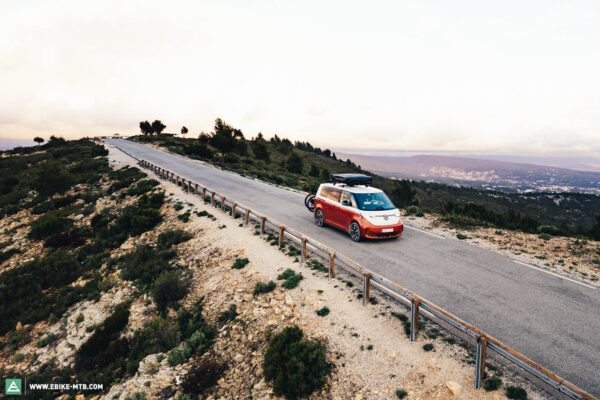
What type of e-mountainbiker are you?
Before you dive into this group test headfirst, it’s important to understand what you actually require from your new bike – we’re happy to help with that! Just check out our interactive buyer’s guide to find out more about yourself and your needs. By answering a few simple questions, we’ll help you make the right decision and provide you with some specific bike recommendations, along with a selection of other articles that you might find interesting and helpful.
Our huge e-mountainbike test field: 27 of the most exciting e-mountainbikes currently available on the market.
Have you ever seen 27 fancy eMTBs lined up on a beach? Probably not! But we have, and it’s a pretty sweet sight, with the cream of the crop of the eMTB world dipping their tires in the azure waters! You wouldn’t even get that in St Tropez! The many different bikes in this eMTB group test reflect the wide range of concepts available on the market, from innovative, cutting-edge competitors to oddball underdogs, along with some familiar faces that have already proven themselves in the past. From XC-oriented light eMTBs for sporty riders to rowdy shredding machines for rough conditions and more sedate trail tourers for leisurely weekend trips, our test field is a very colourful mix of characters.
There are some huge differences between the bikes in this test field, with 12 different drive systems to choose from, and a weight difference of nearly 10 kg between the lightest and heaviest competitor. There’s also huge variance in terms of suspension travel and price. But does it even make sense to compare such different bikes? Not at all – quite the opposite! But that’s not the point of this test either, since we’re not comparing individual parameters on a sheet of paper, but rather analysing the bikes’ individual characters and (riding) qualities, one by one and against each other. And the result was mind-boggling, because we realised that every single competitor suits our test field perfectly in its very own way, with all its strengths and weaknesses. This allows us to provide you with the best possible purchase advice and help you avoid expensive mistakes. Sounds good, doesn’t it?
| Brand | Model | Motor system | Motor power (Nm) | Battery capacity (Wh) | Weight (Kg) | Price |
|---|---|---|---|---|---|---|
| BULLS | VUCA EVO AM 2 | Pinion MGU E1.12 | 85 | 720 | 25 | € 7,999 |
| BULLS | SONIC EVO AM SX-I | Bosch Performance Line SX | 55 | 400 | 18.6 | € 9,999 |
| Canyon | Strive:ON CFR LTD | Bosch Performance Line CX Race | 85 | 750 | 23.6 | € 9,699 |
| Canyon | Torque:ON CF Roczen | Shimano EP801 | 85 | 900 | 25.1 | € 9,399 |
| CENTURION | No Pogo SL R8000i | Bosch Performance Line SX | 55 | 400 | 19 | € 9,999 |
| CUBE | AMS Hybrid ONE44 | Bosch Performance Line SX | 55 | 400 | 18 | € 8,999 |
| FlYER | Uproc X 8.70 | Bosch Performance Line CX | 85 | 750 | 25.1 | € 7,999 |
| FOCUS | SAM² 6.9 | Bosch Performance Line CX | 85 | 750 | 27.1 | € 7,899 |
| GASGAS | ECC 6 | SRAM Eagle Powertrain | 90 | 630 | 24.6 | € 9,999 |
| GIANT | Trance X Advanced E+ Elite 0 I V2 | GIANT SyncDrive Pro2 MG | 85 | 400 | 19.5 | € 11,999 |
| KTM | Macina Scarp SX Prime | Bosch Performance Line SX | 55 | 400 | 17.7 | € 8,399 |
| Lapierre | Overvolt GLP3 | Bosch Performance Line CX Race | 85 | 725 | 23,4 | € 12.499 |
| MERIDA | eONE-SIXTY 10K | Shimano EP801 | 85 | 600 | 21.8 | € 11,599 |
| Mondraker | Neat RR SL | TQ-HPR50 | 50 | 360 | 17.8 | € 11,999 |
| Moustache | Samedi 29 Game 11 FOX | Bosch Performance Line CX | 85 | 750 | 24.6 | € 8,249 |
| Orbea | WILD M-LTD | Bosch Performance Line CX Race | 85 | 625 | 22.3 | € 12,030 |
| Pivot | Shuttle AM Team | Bosch Performance Line CX Race | 85 | 750 | 21.6 | € 14,399 |
| Propain | Ekano 2 CF | SRAM Eagle Powertrain | 90 | 630 | 23.6 | € 9,454 |
| RADON | RENDER 10.0 HD | Bosch Performance Line CX | 85 | 750 | 24.5 | € 5,999 |
| ROTWILD | R.X1000 ULTRA | Pinion MGU E1.12 | 85 | 960 | 24.7 | € 11,999 |
| Santa Cruz | Heckler SL XX AXS RSV | FAZUA Ride 60 | 60 | 430 | 19.3 | € 12,999 |
| SCOR | 4060 Z ST GX | Shimano EP801 | 85 | 720 | 23.1 | € 8,999 |
| SCOTT | Voltage eRIDE 900 Tuned | TQ-HPR50 | 50 | 360 | 19.22 | € 10,999 |
| SIMPLON | Rapcon Pmax Pinion | Pinion MGU E1.12 | 85 | 720 | 24.72 | € 10,984 |
| SPECIALIZED | Turbo Levo SL Expert | Specialized SL1.2 | 50 | 320 | 18.2 | € 9,900 |
| SPECIALIZED | Turbo Levo Pro | Specialized 2.2 Custom Rx Trail Tuned | 90 | 700 | 22.4 | € 11,000 |
| SPHERIK | E-SMT XX AXS | maxon BIKEDRIVE AIR | 40 | 360 | 17.38 | € 13,400 |
If the stats above didn’t paint much of a picture of our test field, here’s a brief summary of each bike to flesh out the bare bones:
The Specialized Turbo Levo Pro is an old acquaintance of ours and takes on the competition with its very own ecosystem. The Californian manufacturer developed not only the frame, but also the entire motor system with all its peripheral hardware components, including the batteries, displays and remotes. The Specialized 2.2 motor is based on the Brose Drive S Mag and is the joint most powerful in this test field, delivering 90 Nm of torque. But can Specialized’s e-classic hold its own against the competition?
GIANT take a similar approach with the Trance X Advanced E+ Elite 0 I V2. Much like the Specialized, it relies on an in-house motor system, the SyncDrive Pro2 MG, developed in close collaboration with Yamaha to deliver 85 Nm of torque. The rest of the hardware, like the remotes, displays and batteries, are also produced in-house by GIANT. The Taiwanese manufacturer relies on a modular battery concept consisting of a 400 Wh battery and 200 Wh range extender. At 19.5 kg, the Trance X Advanced E+ Elite 0 I V2 is the lightest full-power eMTB in our 2024 e-mountainbike comparison test.


Three bikes in this test rely on a proven Shimano motor system, which allows manufacturers to choose their desired battery configuration, thus enabling some surprisingly different approaches and concepts.
The Canyon Torque:ON CF Roczen relies on a Shimano EP801 motor and removable 900 Wh battery – the second biggest in the entire test field. Generating 180/175 mm of travel (f/r), it’s the longest-travel competitor in this test. Alongside the beefy MX look, the Ken Roczen special edition boasts a polarising paint finish, emblazoned with the supercross world champion’s race number. The MERIDA eONE-SIXTY 10K comes equipped with the same Shimano EP801 motor, drawing its power from a smaller 600 Wh battery. It takes on the competition with a fresh look and an exciting new sizing concept. But how does it perform on the trails? With its removable 720 Wh battery, the SCOR 4060 Z ST GX sits right in between its Shimano EP801 peers in terms of battery capacity, and stands out more for its bright finish than the spec. Can it still prove itself against the competition?


We were extremely excited about the contestants built using the Pinion MGU E1.12 motor/gearbox unit. But does it give you a real advantage on the trail, and how does a geared motor compare to conventional motor systems?
With the SIMPLON Rapcon Pmax Pinion, the clue is in the name. The Austrian e-enduro bruiser comes equipped with a Pinion MGU E1.12 motor/gearbox unit, which accommodates both the motor and shifting system in the same sealed housing, and relies on a belt rather than a conventional chain. What advantages does the belt drive offer, and are these noticeable on the trail? The BULLS VUCA EVO AM 2 also relies a Pinion MGU E1.12 motor/gearbox unit, combining it with a beefy look and countless everyday features, including an integrated tail light in the seat stays, a MonkeyLink interface in the cockpit and an SP Connect smartphone stem mount for a highly practical, everyday appeal. The ROTWILD R.X 1000 ULTRA comes in the German manufacturer’s trademark red/gold paint finish with black accents. With its huge 960 Wh battery and Pinion MGU E1.12 drive, it should take you to the summit of the highest peaks. But how does it fare on the way back down?

The Propain Ekano 2 CF features a 630 Wh battery and 90 Nm SRAM Eagle Powertrain motor. It’s one of the most powerful motors in the entire test field, at least on paper, and aims to impress with clever shifting features, like a fully-automatic shifting mode. Moreover, Propain’s extensive online configurator allows you to customise the spec and look of your dream bike down to the smallest detail. The GASGAS ECC 6 relies on the same SRAM Eagle Powertrain motor, with the same shifting features, taking on the competition with a striking moto-style that perfectly matches the brand’s identity and attracts plenty of curious looks on the trail. But does the GASGAS plough its way through the forest just like a motocross machine?
Most of the bikes in our 2024 e-mountainbike comparison test come equipped with a Bosch Smart System motor and peripherals. Not only does the German tech brand have one of the most efficient service networks out there, but also offers a modular hardware system with different displays, remotes and batteries, allowing manufacturers to choose from countless configurations.
Using Orbea’s extensive MyO configurator, you can customise both the spec and look of your WILD M-LTD down to the smallest detail. The Spanish manufacturer even lets you choose the battery size and display! Our WILD M-LTD spec variant comes with a licence to rip and a smaller 625 Wh battery. It relies on an 85 Nm Bosch Performance Line CX Race motor and eagerly chases down the competition with its direct motor tune. The Canyon Strive:ON CFR LTD and Pivot Shuttle AM rely on the same Bosch Performance Line CX Race drive, but combine this with a bigger 750 Wh battery. Unlike the Pivot and Orbea, the Canyon has a removable battery. The Lapierre Overvolt GLP3 pursues the form follows function approach and employs an externally-mounted 725 Wh battery to feed the Bosch CX Race motor. Lapierre’s development team chose performance and optimal weight distribution over looks. In this test, you’ll find out whether the individual concepts work and if they can really take advantage of the Bosch CX Race motor.


The RADON RENDER 10.0 HD relies on a conventional Bosch Performance Line CX motor and removable 750 Wh battery. Retailing at € 5,999, it’s the most affordable competitor with a top-tier spec in the entire test field. But is that enough to secure Best in Test? The FOCUS SAM² 6.9 employs the same Bosch system and combines it with high-quality components on a rather imposing aluminium frame – one of the few alloy bikes in this test. At 27.1 kg, it’s also the heaviest bike in the entire test field – and by a rather big margin. But does it really matter on the trail? French manufacturer Moustache are fully committed to the electric cause and enter the competition with the Moustache Samedi 29 Game 11 FOX, which relies on many in-house parts. Unlike last year’s model, it comes equipped with a FOX FLOAT X air shock rather than Moustache’s proprietary Magic Grip Control shock. Was it still able to impress with its flying carpet feeling? With the FLYER Uproc X 8.70, the premium Swiss brand offer what promises to be an exciting ride, with 150 mm of travel, a mullet wheel setup and a full carbon frame. Unlike its predecessor, however, it’s no longer powered by a Panasonic motor, but rather by a Bosch Performance Line CX drive with a removable 750 Wh battery. Will this concept take the FLYER to the next level this year?
The CUBE AMS Hybrid ONE44 wants to bridge the gap between full-fat and light eMTBs with its Bosch Performance Line SX motor, which delivers 55 Nm of torque and 600 watts of peak power. The drive draws its power from a permanently integrated 400 Wh battery, and the bike is aimed primarily at sporty riders. But can it impress despite its rather unspectacular look? Not only does the BULLS SONIC EVO AM SX-I impress with a perfect chromatic match, but also with countless clever features, including the integrated lighting system and the 400 Wh battery, which can be easily removed from the side of the frame. Like the BULLS, the KTM Macina Scarp SX Prime follows a sporty concept with a Bosch Performance Line SX motor and removable battery. But is that enough?
Not only is the CENTURION No Pogo SL R8000i the smartest bike in the German brand’s history, but also their most expensive model, retailing at € 9,999. It relies on a Bosch Performance Line SX motor with a permanently integrated 400 Wh battery, and features many attractive frame details.

Although the Specialized Turbo Levo SL might not have been the first light eMTB on the market, it’s the one that really got the trend rolling. While other light eMTBs are still in their first generation, or have only just been released, the Levo SL has already gone through several product cycles. Has the new Specialized Turbo Levo SL Expert outgrown the initial teething troubles that the competition may still be suffering from?
A flying saucer? No, it’s just the SCOTT Voltage eRIDE 900 Tuned. With its next-level integration, it immediately stands out from the crowd of eMTBs, as it looks like something from outer space. Is the high level of integration enough for the Voltage eRIDE to beat the competition? Like the SCOTT Voltage, the Mondraker Neat RR SL relies on a slim 50 Nm TQ-HPR50 motor and 360 Wh battery, which is seamlessly integrated into the frame. With its light-footed handling, the Spanish wild horse wants to come off as an analogue bike, both visually and on the trail. But does it succeed? The Santa Cruz Heckler SL XX AXS RSV is the only bike on test with a FAZUA Ride 60 motor and takes on the competition with the typical Santa Cruz style and trademark VPP rear suspension. It rolls on a mullet wheel setup, and promises top riding fun with plenty of power on the climbs. Can it keep its promise? With the Spherik E-SMT XX AXS, the Canadian brand enters the race with a truly exotic contender. Tipping the scales at 17.4 kg, it’s the lightest bike in the entire test field. Just as rare is the maxon BIKEDRIVE AIR motor, which delivers 40 Nm of torque, making it the weakest motor on test. But does this make the Spherik the underdog in this test?

The motor systems in our 2024 e-mountainbike group test: which e-bike motor concept suits you best?
We’ve all played Top Trumps: the car with the highest performance trumps the weaker ones. Unfortunately, it’s all too easy to do the same when comparing the performance of e-bike motors. However, there are many factors that define a motor system and contribute to its overall performance, which can’t be reduced to mere numbers. Once again, it’s all about creating a successful overall package! Maximum power, responsiveness, modulation, power delivery, and noise all contribute to the riding experience of a motor, while the ecosystem around the motor determines whether it’s a joy to use or simply results in frustration. Do you need some help finding the motor concept that suits you and your requirements best? Then you should read our big e-bike motor comparison test with 13 motor systems. Here you’ll get a glimpse of the most important terms and key figures, as well as an in-depth insight into the electrifying world of e-bike motors. In addition, we’ll provide you with countless exciting findings from both our lab and practical tests,and also dispel a few common myths. As you will see, there is no such thing as the best ebike motor!


Where and how did we test the e-mountainbikes?
Sun, beach, dry trails! That’s undeniably the top three priorities of every mountain biker! We escaped the cold German winter to find the best possible conditions to put the 27 eMTBs through the wringer. This year’s e-mountainbike group test was an emotional rollercoaster, with plenty of highs and lows filling our days: endless laps, late-night wrenching sessions and nerve-racking battery-charging marathons – until the power grid collapsed! The finca we rented sat on the top of a hill, offering breath-taking views over the surrounding mountains and the sea glimmering on the horizon, but also a glimpse into the lush trail network of the area – we were pumped from the moment we woke up!

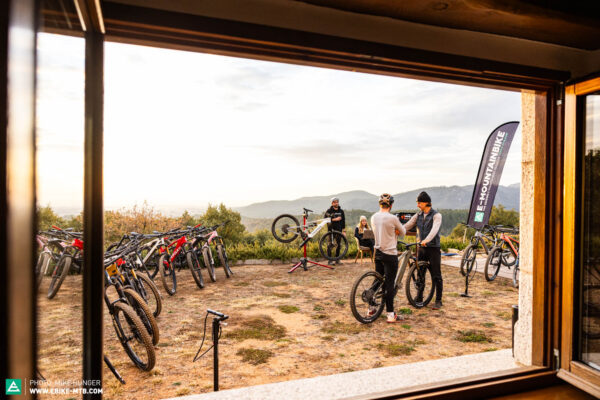

But where exactly did we go? We travelled to the small town of Santa Coloma de Farners, about an hour’s drive north-east of Barcelona. With its countless trails, this area offers the ideal conditions for such a huge e-mountainbike comparison test. The local trail centre is a colourful and harmonious ensemble of fast, flowing trails with sharp corners, jumps and nasty rock gardens. Our test route – a blend of “Dragon Khan” and “La Llosa” – is peppered with roots, flowing berms, sandpaper-like rock slabs and loose, sandy corners. The climb to the trailhead has a bit of everything, from wide gravel paths with potholes that could swallow you whole, to tricky uphill chutes with steps and tight bends, that tested not only the bikes and components, but also our test crew.

Our E-MOUNTAINBIKE test crew

When I ride bikes, I prefer to do it at a leisurely pace – I leave the shredding to the others. When it comes to choosing an e-mountainbike, touring capabilities and a comfortable riding position are just as important to me as clever features, both for longer adventures and for everyday riding. Nevertheless, good all-round characteristics are very important too, as I still like to tackle the odd more exciting trail on my tours. That’s why intuitive, confidence-inspiring handling is crucial to me.

Although I’m one of the young bucks in the test crew, I’ve been riding analogue MTBs for years. E-mountainbikes are still new territory for me and I don’t want to blow my bank account straight away. That’s why I’m looking at the more affordable e-mountainbikes in this test, hoping to get a good start in the eMTB world. However, high performance is paramount for me to enjoy riding, and an intuitive motor system would be the icing on the cake. Personally, looks aren’t my main priority.

I got straight into e-biking and it’s exciting to see all the different concepts that are available on the market. Especially on demanding trails – like the ones around Santa Coloma – I appreciate an e-MTB with good-natured handling and plenty of reserves, that won’t throw you straight into the bushes if you lose your nerve or make a mistake.

I’m a thoroughbred e-mountainbiker, regularly riding my eMTB on home trails. However, I also use my eMTB to commute to the office, meaning that intuitive handling and a capable spec are just as important as clever everyday features, like an integrated lighting system or integrated anti-theft device.

As editor-in-chief of our sister magazine ENDURO, I mainly ride analogue MTBs. When I jump on an eMTB, I’m up for a real climbing challenge – I like to enjoy the ascent on tricky, technical trails, rather than just cruising to the summit along dirt tracks. Therefore, a powerful motor with direct response behaviour and light-footed handling are of paramount importance to me. In addition, the riding position and suspension performance have to be just right, so I can get over nasty steps and swing around tight hairpin corners. When gravity takes over, I like to turn it up to eleven, so an uncompromising, downhill-oriented spec is key.

A healthy diet, a good work-life balance and plenty of exercise are my top priorities. Coffee and unhealthy food are a no-go. I like the sporty, light eMTBs best, as they require more physical effort, meaning that I have to work hard to earn my next bowl of muesli! Depending on the concept, they reward you with a natural ride feeling and light-footed handling when riding downhill – perfect!

When I’m out and about on my e-mountainbike, it’s always with my dog Henry. When we’re not testing the best bike dog trailers for our sister magazine DOWNTOWN, we explore the woods together and check out the wildlife. That’s why trailer approval and a powerful motor are my main priorities, as I have to carry a dog trailer and pull a 30 kg labradoodle up all of the hills. A sophisticated navigation system is a plus when I venture further afield.

When I’m not wrenching on my Land Rover or racing analogue enduro, you’re most likely to see me riding an eMTB, which I consider to be the ultimate training tool. This allows me to squeeze plenty of descents into my super tight schedule, and to loop trails several times without getting too out of breath straight away. I don’t have time to muck about, so a sophisticated motor system and easy serviceability are high on my list of priorities. Of course, good downhill performance is a must.

As the team’s connectivity expert, “standard” isn’t good enough for me. That’s why I love to delve deep into the bikes’ smallest details and spend plenty of time studying the countless apps from both bike and motor manufacturers. Customisation is high on my priority list as it allows me to adapt the bike to my own needs. It’s incredibly cool that more and more manufacturers offer new technology and software updates to round off the user experience.
Our 2024 e-mountainbike comparison test in numbers
€ 280,097
- is the total retail value of our test field.
€ 10.374
- Is the average price of our eMTBs.
- This is around € 777 less than last year’s 2023 group test.
€ 5.999
- Is what you pay for the cheapest bike in the entire test field, the Radon Render 10.0 HD.
€ 14.399
- Is the price of the most expensive e-mountainbike in this test, the Pivot Shuttle AM Team XX Eagle Transmission – this is more than twice as much as the cheapest option.
180/175 mm (f/r)
- Is the travel of the most capable bike in test, the Canyon Torque:ON CF Roczen.
140/130 mm (f/r)
- is what the shortest-travel competitor generates, the BULLS SONIC EVO AM SX-I.
160/153 mm (f/r)
- Is the average travel in our 2024 e-mountainbike group test.
15 bikes roll on 29” wheels.
12 bikes rely on a mullet wheel setup, with a 29” wheel at the front and 27.5” wheel at the rear.
- That’s twice the proportion of mullet bikes than appeared in last year’s test field.
25 bikes have a carbon frame.
Only 2 bikes rely on an alloy frame.
17.38 kg is what the lightest bike in this test weighs, the Spherik E-SMT XX AXS.
27.1 kg is the weight of the heaviest competitor, the FOCUS SAM² 6.9.
21.9 kg
- Is the average weight of our test field.
- That’s 0.2 kg lighter than last year.
At 320 Wh, the Specialized Turbo Levo SL Expert has the smallest battery capacity.
With a whopping 960 Wh, the battery of the ROTWILD R.X1000 ULTRA is the biggest on test.
- 17 removable batteries.
- 10 permanently integrated batteries.
At 40 Nm, the maxon BIKEDRIVE AIR of the Spherik E-SMT XX AXS delivers the lowest torque in the entire test field.
The most powerful motors deliver 90 Nm of torque.
9 motor manufacturers are represented in this test
- Bosch is the most popular, with 12 of the 27 eMTBs relying on a Smart System drive.
What mishaps happened during this test?
- 2 motor covers disintegrated
- 1 wheel had to be trued
- 1 crankset exploded
- 1 belt ripped
- 2 headlights snapped off
- 1 Shimano bike with a dodgy battery contact
What should you look for when buying an e-mountainbike?
Donald Duck or Mr. Scrooge? Before you spend your hard-earned money on your new dream eMTB, it’s important to understand which overall concept suits your personal needs and requirements best. Rather than picking a bike because it has the most powerful motor or biggest battery, you should ask yourself a few basic questions. After all, most bikes can only live up to their full potential if they’re used as intended and, by default, you’ll only be happy if you find a bike that suits your needs and riding style.


It all comes down to the overall concept
Compared to analogue bikes, e-mountainbikes are far more complex – they’re far more than just a frame with a battery and motor. Manufacturers have to take into account many more factors, like the integration of the drive and battery, and the weight distribution of heavy components, which must harmonise with one another in order to offer a coherent package – even the smallest deviation can make a huge difference to the handling. In a nutshell, while the best motor is only as good as the eMTB it’s part of, on the other hand, the bike is only as good as the motor concept allows it to be. You guessed it – it’s all about the right overall concept!

How much torque should an e-mountainbike deliver?
If you take a look at our table, many of the e-mountainbikes in this test share similar torque values. On the trail, however, they’re totally different in terms of power delivery, proving clearly that sheer numbers and torque values say very little about a bike’s performance, and that a simple software tweak can make a huge difference on the trail. The Bosch Performance Line CX Race motor is perhaps the best example: while nearly identical to the conventional Performance Line CX motor on paper, both churning out 85 Nm torque, the tweaked software ensures a stronger, more abrupt power delivery, transferring more power to the ground at lower cadences and lighter rider inputs. The Shimano EP8 motor also has 85 Nm of torque, but can’t keep up with either version of the Bosch CX motor, despite sharing the same values on paper. The optimal cadence range – i.e. the range at which the motor delivers its power most efficiently – varies enormously from drive to drive, with many of the motors in this test only reaching their full power at a certain cadence. Once again, there’s much more to e-mountainbikes than sheer numbers, and the overall performance can only be determined on the trail.


The bigger the battery, the bigger the range?
In a word: no! The range depends on plenty of factors, including the rider’s weight and riding style. Moreover, battery capacity always has to be considered in relation to the motor’s power and behaviour, and as such its power consumption. Furthermore, the choice of tires and tire pressures, as well as the suspension’s efficiency and countless other factors all combine to influence the range. This means that a weak motor with a small battery might take you just as far as a powerful yet thirsty motor with a large battery. On the other hand, this will provide less assistance and require more physical effort.


What useful additional features should an e-mountainbike have?
Many bikes in this test come with practical features and detail solutions that prove useful in many riding scenarios. For example, a cleverly integrated lighting system, like the ones you get with the MERIDA eONE-SIXTY or BULLS VUCA, don’t bother you on the trail and come in handy when stretching a trail session far into the night, or commuting to work with your eMTB. Especially in the last scenario, it’s of great advantage to have a removable battery that can be charged externally without having to carry the bike into an office or house if you don’t have a plug in your bike storage or garage. Alongside the optional features you can pick when purchasing your bike, you can choose from a vast range of aftermarket accessories that can be retrofitted at a later date, while a constant stream of software updates and extensions allows you to keep your bike software up to date. You don’t have to subscribe to all of the available services right away and can always do it later – and cancel when you don’t require it anymore. For example, Bosch allow you to complement an old-school lock with their eBike Lock theft protection function, which can be activated directly via the bike’s software and shuts down the motor functions. So, when buying, be aware of what you need or might want to retrofit in the future and find out about the compatible options.


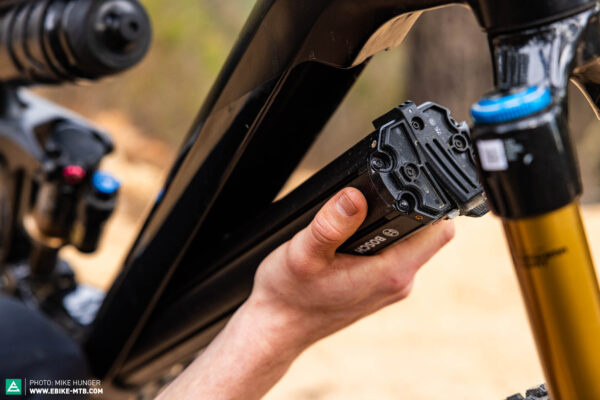
Light eMTB, full-power, or something in between?
The gap between light and full power eMTBs is narrowing fast, with an increasing number of concepts struggling to fit into either category. Many motor manufacturers rely on modular systems with different motors, different-size batteries and several remote and display options, thus giving bike manufacturers plenty of freedom with their configurations.
Some of the bikes in this test come equipped with the Bosch Performance Line SX motor, which has less torque than its full-fat CX counterpart, but delivers the same peak power. This allows sporty riders to keep up with full-power motors, provided they ride in the strongest support mode. The MERIDA eONE-SIXTY, on the other hand, combines a powerful Shimano EP801 motor with a smaller, lighter 600 Wh battery.
Before deciding on a concept, you should ask yourself how you want to use your new e-mountainbike. Do most of your riding buddies ride full-fat eMTB all-rounders, or do you ride lots in groups with light eMTBs and analogue bikes? Or maybe you prefer exploring the wilderness all by yourself?

If your mates ride full-fat eMTBs, a powerful motor with plenty of torque might be the most sensible choice. After all, no one likes to be that guy that holds everyone up, spitting out his lungs on the first steep climb! As a rule of thumb, the highest support mode of a light eMTB corresponds to roughly the intermediate support mode of a full-power ebike. If your mates with full-power e-mountainbikes ride primarily in the weakest support modes, you can still keep up on a light eMTB in one of the higher support levels. But be aware! More power means more battery consumption! If you want to play it safe, you should opt for a full-fat eMTB all-rounder.

If your riding group is made up almost entirely of light eMTBs or even analogue bikes, there are plenty of different light eMTB concepts to choose from. But remember, light motors usually require a higher pedalling cadence and more physical effort than full-power eMTBs. Most light eMTBs allow you to configure the motor settings to adjust the assistance to suit your very own requirements and needs. Range isn’t usually an issue with such a low level of assistance, but if you run out of juice, or simply want to save some for the end of the tour, light eMTBs are easy to pedal even without assistance.
But why is there no point in choosing the best eMTB?
The best e-mountainbike is only as good as its set-up. The right setup is the key to exploiting the full potential of both the bike and its components. During our e-mountainbike testing sessions, we spend a huge amount of time setting up the bikes correctly. After all, you wouldn’t drive a car with the seat slammed all the way to the back if you have short legs! Of course, setting up a bike to suit you takes plenty of time and knowledge – and with the latter we can help! In our setup guide, we’ll help you find the perfect setup for your eMTB.

The tops and flops from our 2024 e-mountainbike comparison test
Tops

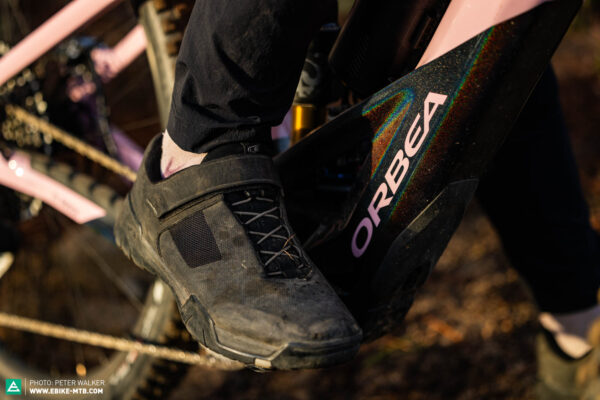

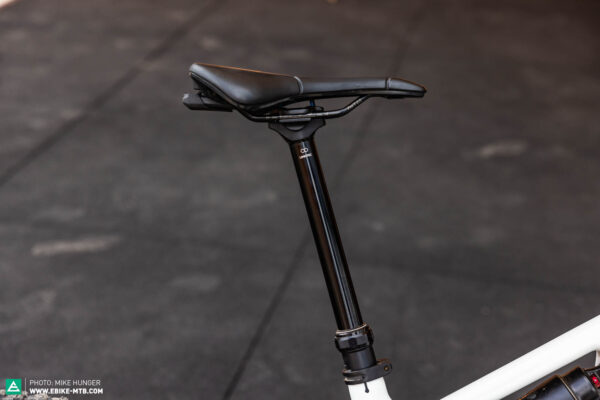



Flops






An overview of all of the e-mountainbikes bikes in our huge 2024 comparison test
The BULLS SONIC EVO AM SX-I in our huge 2024 e-mountainbike comparison test
Just like the Silver Arrows in the 1930s, the BULLS SONIC EVO AM SX-I boasts a classy silver and black look, with the components perfectly matching the bike’s colour scheme. The classy appearance is rounded off by clever everyday features, like the integrated lighting system. The SONIC EVO AM excels above all on moderate, flowing trails but quickly reaches its limit on technical descents.
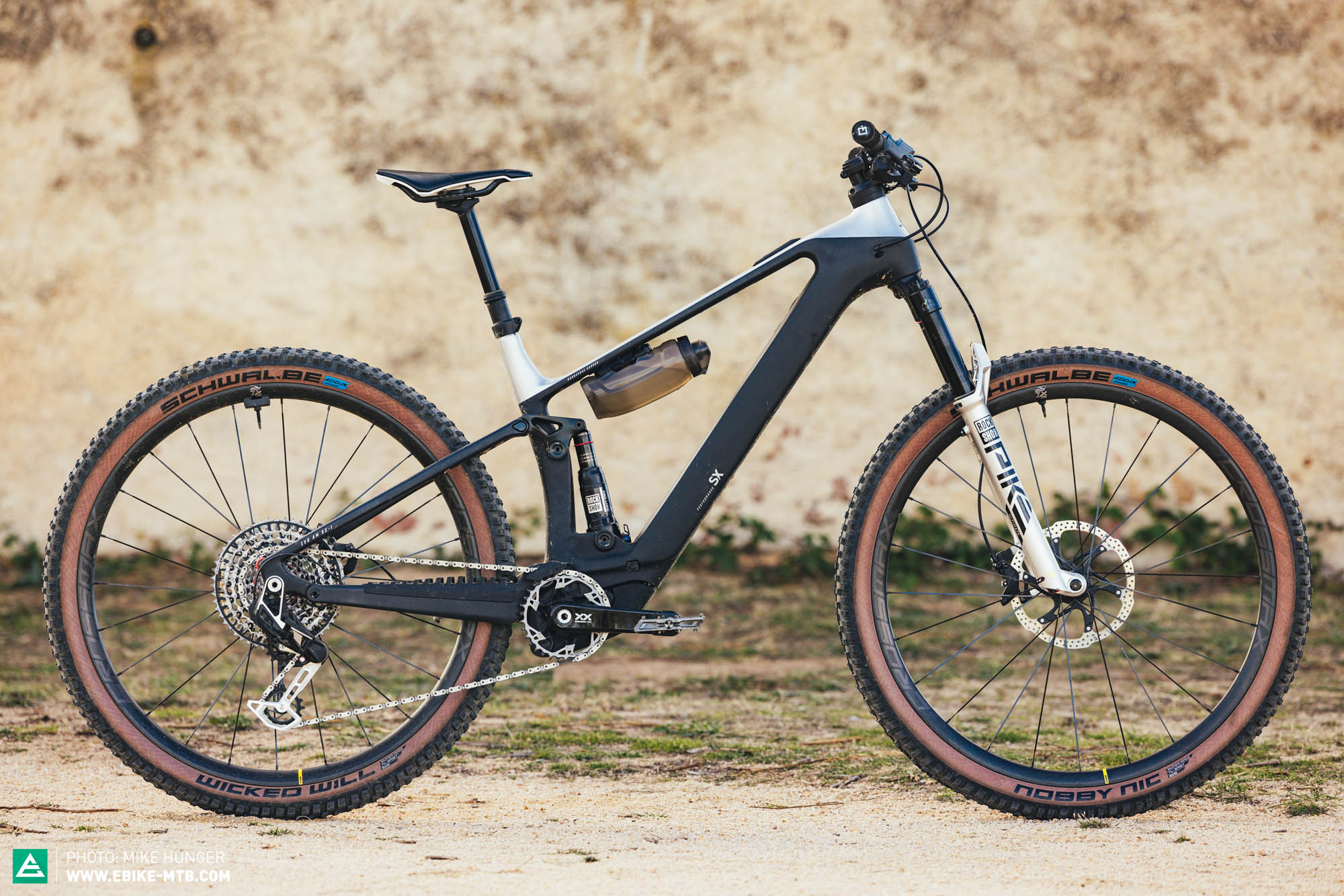
18.6 kg | € 9,999 | Click for review


The Canyon Torque:ON CF Roczen in our huge 2024 e-mountainbike comparison test
The Canyon Torque:ON CF Roczen lets you know straight away what its intentions are. Our Ken Roczen Limited Edition test bike, which is the signature model of the multiple supercross world champion, boasts a unique, beefy look with an aggressive-looking coil shock and polarising paint finish. The Torque:ON is particularly good at one thing: ripping! It combines a high level of composure with excellent traction, inspiring huge amounts of confidence in the process. Although this comes at the expense of the bike’s agility and all-round capabilities, it makes it the ideal partner for big days out on steep, rough and fast terrain.
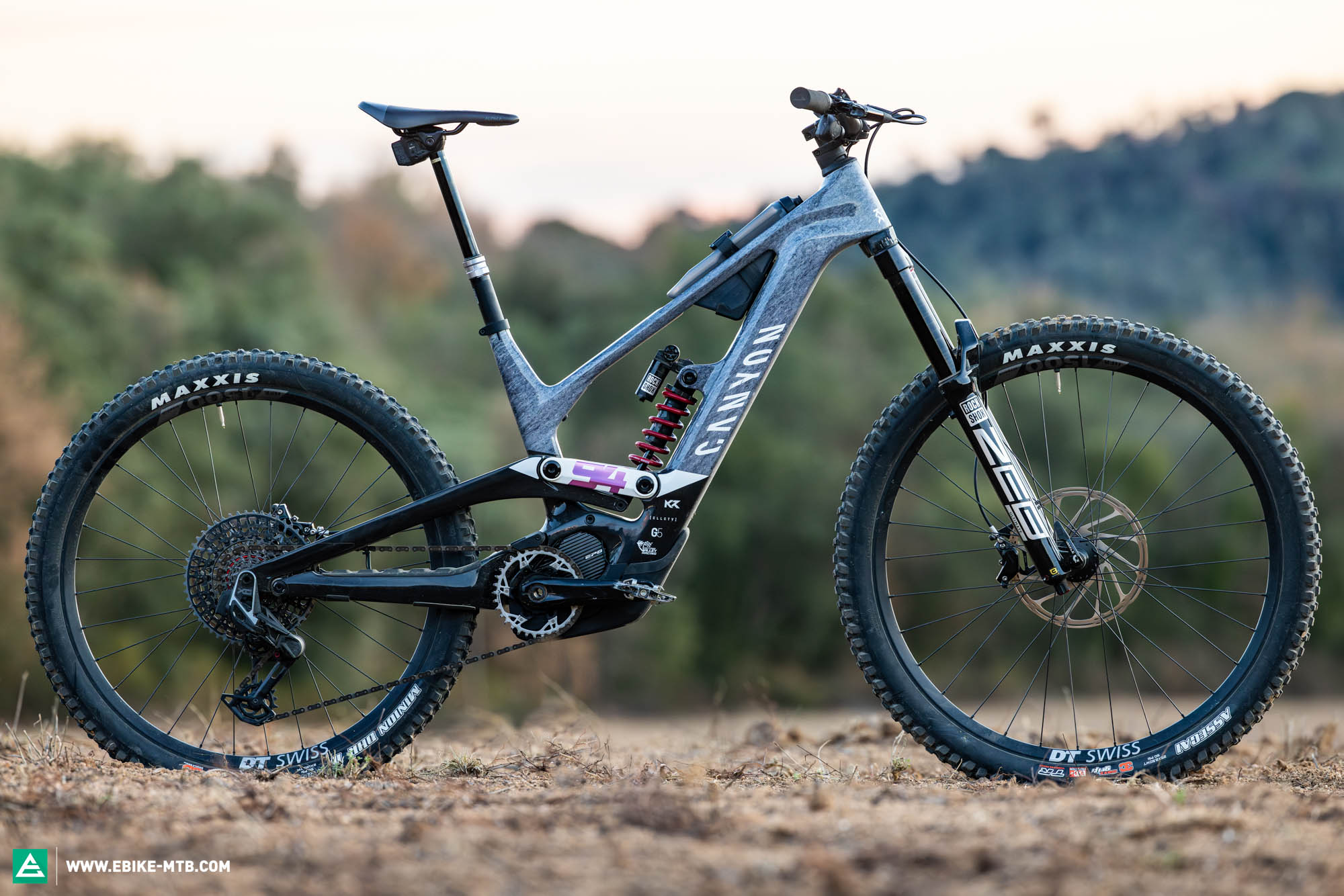
25.1 kg | € 9,399 | Click for review


The CENTURION No Pogo SL R8000i in our huge 2024 e-mountainbike comparison test
The German brand’s red rocket combines an elegant design and clever, well thought-out detail solutions, with a top-tier spec providing the proverbial icing on top and bumping up the price to a hefty € 9,999. The firm, direct handling, however, make it primarily suitable for experienced, sporty riders and shorter, fast-paced rides on moderate terrain.

19 kg | € 9,999 | Click for review
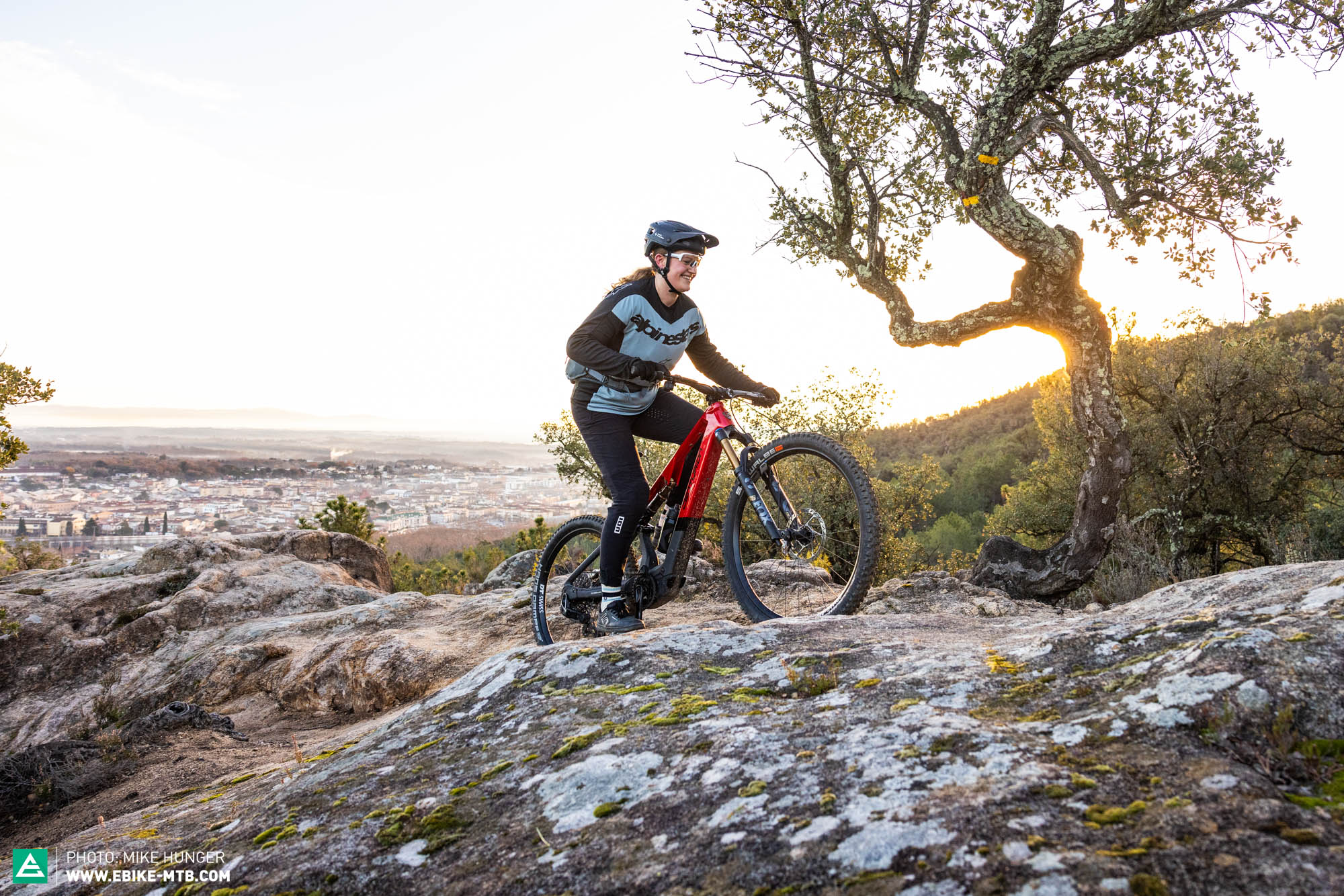

The CUBE AMS Hybrid ONE44 in our huge 2024 e-mountainbike comparison test
Well camouflaged! Although discreetly understated at first glance, the CUBE is packed with trail performance. It’s an inconspicuous all-rounder, and will appeal to sporty riders with its comfortable touring character, while the intuitive handling makes it an excellent trail companion for both beginners and experienced riders.

18 kg | € 8,999 | Click for review


The FLYER Uproc X 8.70 in our huge 2024 e-mountainbike comparison test
Like the CUBE AMS Hybrid ONE44, the FLYER Uproc X 8.70 scores with a well-rounded overall package rather than a fancy look, and is one of the few bikes in this test with an integrated mini tool. Swiss quality at a fair price, with intuitive handling for trail newbies.

25.1 kg | € 7,999 | Click for review


The FOCUS SAM² 6.9 in our huge 2024 e-mountainbike comparison test
The FOCUS SAM² 6.9 makes its intentions clear even from a distance: it’s here to shred! While the climb is just a means to an end for the FOCUS, it still impresses with excellent touring capabilities. While at 27 kg, it’s the heaviest bike in the entire group test, it shines with a very composed character and excellent suspension. Agility only plays a subordinate role with the FOCUS – it prefers to shred its way back down into the valley in a straight line.

27.1 kg | € 7,899 | Click for review
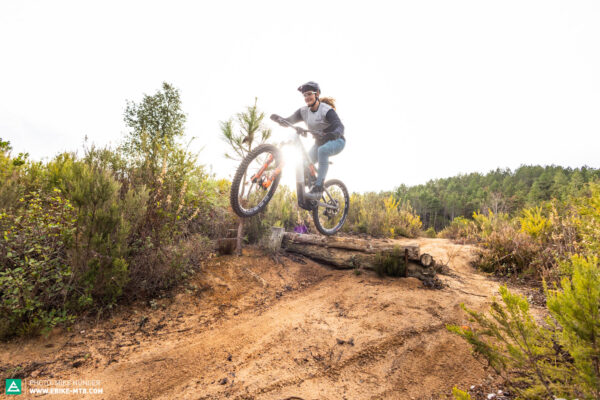

The GASGAS ECC 6 in our huge 2024 e-mountainbike comparison test
“Striking, radical, polarising” are the three words that best describe the GASGAS ECC 6. In many ways, it’s reminiscent of the Spanish brand’s motocross bikes, which makes it a real head turner on the trail. Here it impresses with confidence inspiring, beginner-friendly handling, but it can’t keep up with the competition in terms of agility – other bikes put an even bigger smile on your face. Although the ECC 6 was designed for another kind of riding, the comfortable riding position and SRAM’s Eagle Powertrain motor with auto-shift function inadvertently make it an excellent touring companion.

24.6 kg | € 9,999 | Click for review


The GIANT Trance X Advanced E+ Elite 0 I V2 in our huge 2024 e-mountainbike comparison test
The GIANT Trance X Advanced E+ Elite 0 I V2 wants to combine the best of both worlds with its powerful 85 Nm SyncDrive Pro2 MG motor and modular battery system, which consists of a small 400 Wh battery and optional 200 Wh range extender. In terms of sheer power, it can keep up easily with the other full-fat eMTBs on climbs, but it struggles to transfer the power to the ground, which is due to a combination of the motor’s harsh response and the shallow-profiled tires.

19.5 kg | € 11,999 | Click for review


The KTM Macina Scarp SX Prime in our huge 2024 e-mountainbike comparison test
With its Bosch Performance Line SX motor and 400 Wh battery, the KTM Macina Scarp SX Prime combines an XC bike and trail eMTB in one concept. The sporty riding position and agile handling make you feel like an XC racer on climbs, while the excellent composure and high fun factor make it a capable companion on the trail. At 17.7 kg, it’s also one of the lightest bikes in the entire test field.

17.7 kg | € 8,399 | Click for review
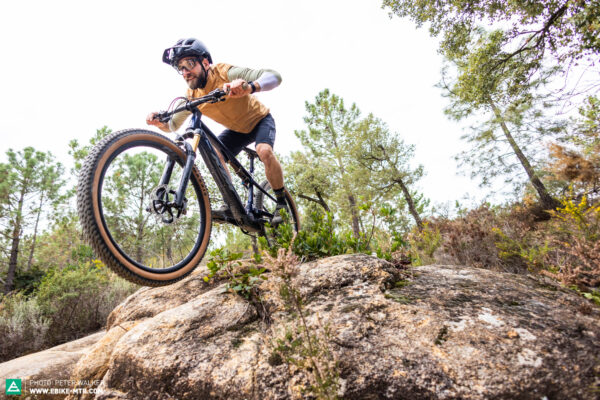

The Lapierre Overvolt GLP3 in our huge 2024 e-mountainbike comparison test
The Lapierre Overvolt GLP3 is primarily aimed at racers and hard-core gravity enthusiasts. To achieve this, the French manufacturer pursued a consistent form-follows-function design and combined it with a Bosch Performance CX Race motor and external battery, delivering a mean trail machine with extremely direct handling that allows experienced riders to reach previously unimagined speeds. However, the Lapierre doesn’t allow for riding mistakes, punishing you immediately if you get distracted.

23.4 kg | € 12,499 | Click for review

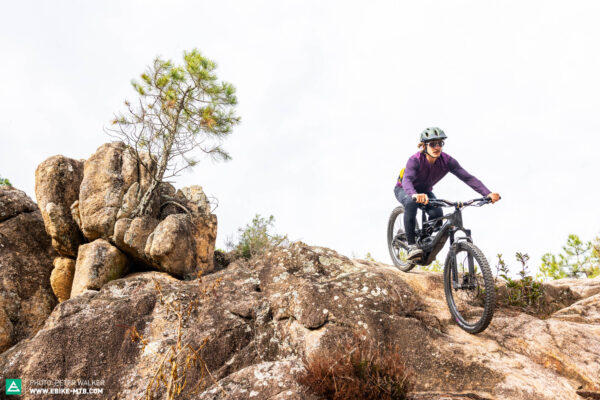
The MERIDA eONE-SIXTY 10K in our huge 2024 e-mountainbike comparison test
The new MERIDA eONE-SIXTY takes on the competition with a top-tier spec and an exciting new sizing concept. On the trail, it can easily keep up with the best e-mountainbikes in this test, impressing above all with its good-natured and intuitive handling, which makes it suitable for both beginners and advanced riders. The frame features countless clever detail solutions, like the multitool and integrated headlight, boosting its user-friendliness and all-round capabilities even further.

21.8 kg | € 11,599 | Click for review


The Mondraker Neat RR SL in our huge 2024 e-mountainbike comparison test
With its unmistakable frame silhouette and striking branding, the Mondraker NEAT looks fast before you even start riding, with its distinctly recognisable Mondraker styling. The TQ-HPR50 motor and 360 Wh battery are integrated seamlessly into the frame, ensuring a discreet overall look and making Mondraker’s light eMTB look a lot like an analogue bike – and the light-footed handling also makes it feel like one on the trail! However, the Neat RR SL is aimed more at experienced riders who know how to tame the fiery Spanish temperament.
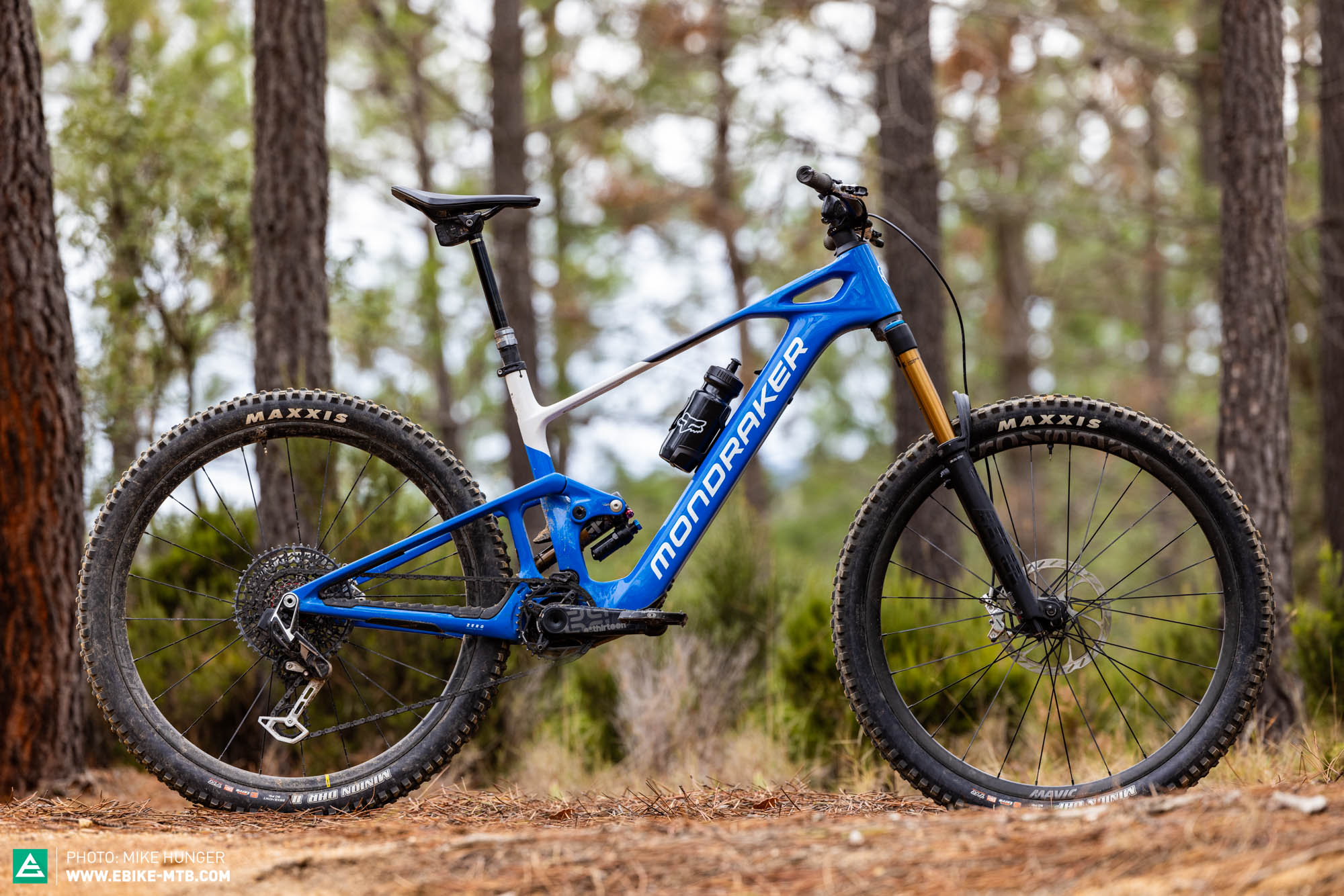
17.8 kg | 11,999 € | Click for review


The Moustache Samedi 29 Game 11 FOX in our huge 2024 e-mountainbike comparison test
The Moustache Samedi 29 Game 11 FOX takes on the competition with an old-school look and is one of the few bikes featured here with an alloy frame. The predictable handling is ideal for beginners and makes you feel at ease right from the get-go. For active riders, on the other hand, the plush suspension might be a limiting factor. That said, the powerful Bosch Performance Line CX motor, comfortable rear suspension and relaxed pedalling position make it a fantastic touring companion.

24.6 kg | € 8,249 | Click for review


The Pivot Shuttle AM Team XX Eagle Transmission in our huge 2024 e-mountainbike comparison test
The Pivot Shuttle AM XX Eagle Transmission is a mean cornering machine, with the small rear wheel ensuring playful handling. With its agile character, the Pivot delivers truckloads of riding fun, regardless of whether you’re cruising the flow or tackling the gnar, delivering a tremendous performance in all situations. It doesn’t shy away from technical climbs either, where it impresses with the direct, powerful Bosch Performance Line CX Race motor and efficient rear suspension.

21.6 kg | € 14,399 | Click for review


The Propain Ekano 2 CF in our huge 2024 e-mountainbike comparison test
The Ekano 2 CF comes equipped with a SRAM Eagle Powertrain motor. In Propain’s eMTB portfolio, it’s the bike for the rough stuff, impressing above all with plenty of reserves and excellent composure on the trail. Moreover, Propain’s extensive configurator allows for countless customisation options, making the Ekano 2 CF suitable for a wide range of riders and applications.

23.6 kg | € 9,454 | Click for review


The RADON RENDER 10.0 HD in our huge 2024 e-mountainbike comparison test
The RADON RENDER 10.0 HD might be the most affordable bike in the entire test field, but it comes with a top tier spec. However, on the trail, it struggles behind the rest of the test field, failing to fulfil the expectations. While still plenty of fun on flowing trails, it quickly reaches its limits on technical trails, where the handling becomes increasingly demanding.

24.5 kg | € 5,999 | Click for review
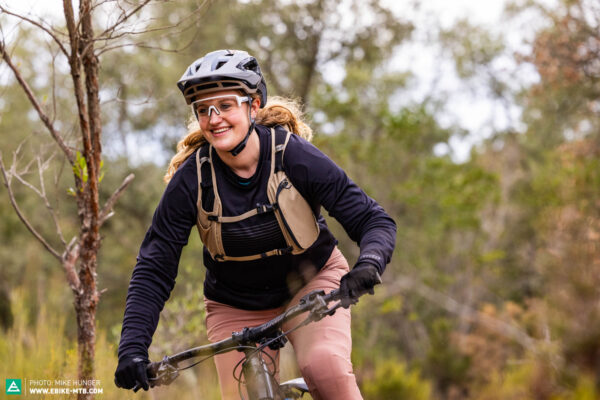

The ROTWILD R.X 1000 ULTRA in our huge 2024 e-mountainbike comparison test
The ROTWILD R.X 1000 ULTRA will appeal primarily to touring riders. The Pinion MGU E1.12 motor/gearbox unit provides a wide gear range, allowing you to negotiate even the steepest of climbs, while the massive 960 Wh battery gives you enough juice for the most epic backcountry expeditions. The R.X 1000 also comes with practical features like the integrated USB-C charging port and MonkeyLink light mount on the stem. However, it quickly reaches its limits on technical climbs and demanding terrain.

24.7 kg | € 11,999 | Click for review


The Santa Cruz Heckler SL XX AXS RSV in our huge 2024 e-mountainbike comparison test
Looks like a Santa Cruz! With its unmistakable look and striking VPP rear suspension, the Heckler SL AXS RSV is distinctly recognisable as a Santa Cruz. The top-tier spec perfectly matches its intended use. The FAZUA Ride 60 motor and 430 Wh battery are integrated seamlessly and elegantly into the frame. On the trail, the Santa Cruz impresses with good climbing characteristics, offering a great balance between agility and composure. This ensures maximum riding fun and puts a massive grin on your face, whether you’re a beginner or a more experienced rider.

19.3 kg | € 12,999 | Click for review


The SCOR 4060 Z ST GX in our huge 2024 e-mountainbike comparison test
The SCOR 4060 Z ST GX is just as nimble on the trail as its salmon colour suggests. The lively handling encourages you to play with the trail, plastering a massive grin on your face in the process. The overall excellent impression is rounded off by a trail-oriented spec and powerful Shimano EP801 motor with removable 720 Wh battery.

23.1 kg | € 8,999 | Click for review


The SCOTT Voltage eRIDE 900 Tuned in our huge 2024 e-mountainbike comparison test
Ladies and gentlemen, please welcome the master of integration, the king of illusion! No, we’re not talking about Houdini, but the SCOTT Voltage eRIDE 900 Tuned. It hides the shock and TQ-HPR50 motor inside the carbon frame, and comes with countless interesting features. Alongside the mind-boggling level of integration, the Voltage eRIDE offers a tremendous performance on the trail, impressing uphill with a natural ride feeling and downhill with precise, intuitive handling.

19.22 kg | € 10,999 | Click for review
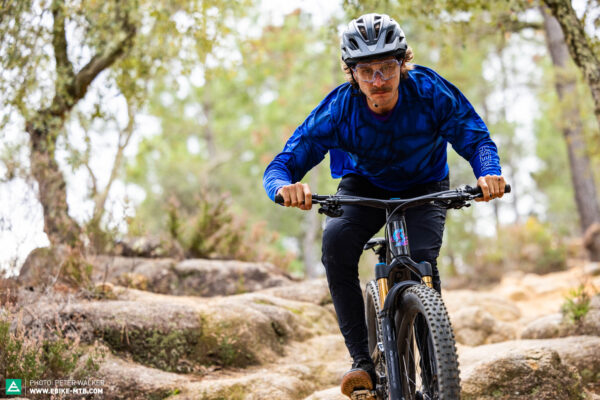

The SIMPLON Rapcon Pmax Pinion in our huge 2024 e-mountainbike comparison test
As the name suggests, the SIMPLON Rapcon Pmax Pinion relies on a Pinion MGU E1.12 motor/gearbox unit, taking advantage of the internal shifting system’s huge gear range on longer tours. On the trail, it impresses with lots of comfort and good-natured handling, both up and downhill, although for active riders, the plush suspension lacks a little feedback from the ground. Both the spec and look of the Rapcon Pmax Pinion can be customised using SIMPLON’s extensive online configurator.

24.72 kg | € 10,984 | Click fore review


The Specialized Turbo Levo Pro in our huge 2024 e-mountainbike comparison test
Although the Specialized Turbo Levo is an old acquaintance of ours, that doesn’t mean that it’s outdated. On the contrary – it’s actually one of the most popular eMTBs currently available on the market. Even after many years, Specialized’s holistic approach still makes perfect sense. On the trail, the Turbo Levo continues to kick butt, outperforming many of its newer opponents in this comparison test with first-class all-round characteristics and a tremendous trail performance.

22.4 kg | € 11,000 | Click fore review


The Spherik E-SMT XX AXS in our huge 2024 e-mountainbike comparison test
With its unconventional maxon BIKEDRIVE AIR motor system and bling spec, the Canadian newcomer is truly exotic, ensuring plenty of curious looks at the trail centre car park. On the trail, however, it reveals some weaknesses, and is held back considerably by its own spec. With its demanding handling and weak motor, it’s only suitable for an extremely narrow target group, which sends it right down to the bottom of the test field.

17.38 kg | € 13,400 | Click for review
Our Best Buy Tip: the Canyon Strive:ON CFR LTD
Best bang for the buck! Riding performance and a high-quality spec play just as important a role as the price when it comes to picking our Best Buy tip. With its Bosch Performance Line CX Race motor and 170/160 mm of travel, the Canyon Strive:ON CFR LTD keeps up with the best bikes in this test. It’s intuitive and predictable to ride, striking an excellent balance between agility and composure, while at the same time proving an excellent all-rounder with its comfortable character and removable battery. The Canyon Strive:ON CFR LTD comes with a near-impeccable spec, and a fair price of € 9,699.
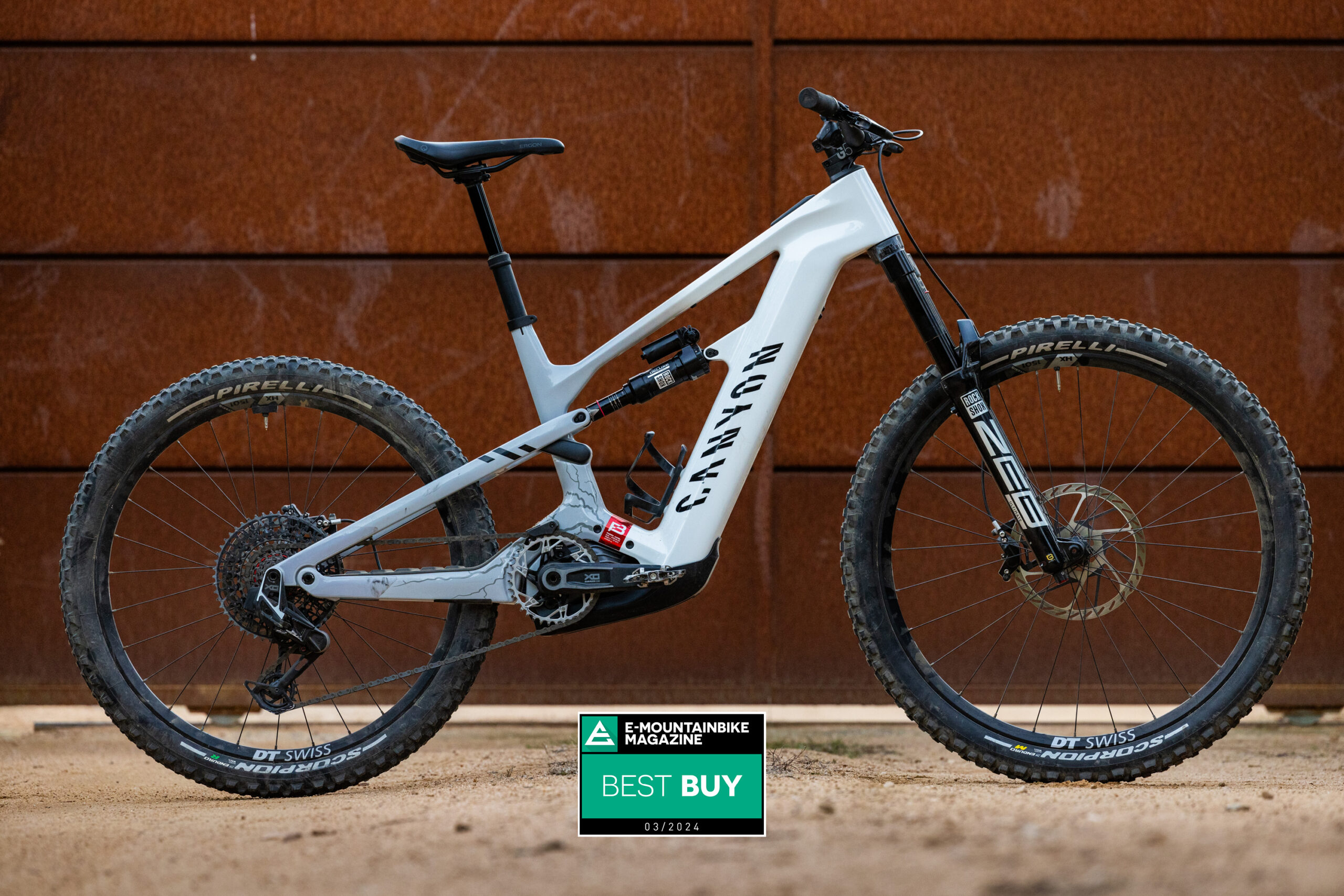
23.9 kg | € 9,699 | Click for review

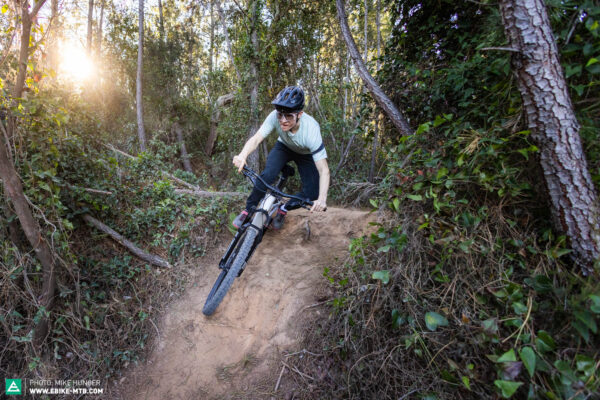
The best eMTB of 2024: the Orbea WILD M-LTD
The Orbea WILD M-LTD already savoured the sweet scent of victory in last year’s comparison test. On the trail, Orbea’s € 12,030 eMTB is ahead of its time and simply makes the rest of the test field look dated, impressing above all with its first-class suspension, confidence-inspiring handling and mind-boggling versatility, which makes it an excellent choice for a wide spectrum of riders. At the same time, it proves a strong all-rounder, delivering a tremendous performance both on leisurely tours and uphill. Not only is it the best bike in our 2024 eMTB comparison test, but potentially the best eMTB for you, because Orbeas’ extensive configurator allows you to customise both the spec and look of your WILD down to the smallest detail.

22.3 kg | € 12,030 | Click for review


More exciting recommendations from our 2024 test field
Both our test winner and Best Buy tip, the Orbea WILD M-LTD and Canyon Strive:ON CFR LTD, have secured their titles for a reason and should be the ideal companion for most eMTBers. That said, every rider has their own needs and requirements, so depending on your situation, you might be better off buying a touring or Light-eMTB. Here are some recommendations from our editorial team, which should include a suitable bike for everyone.
BULLS VUCA EVO AM 2 – The best eMTB for touring and everyday use
With its imposing presence and performance-oriented spec, the BULLS VUCA EVO AM 2 looks like a rowdy eMTB bruiser. Despite the predictable handling, it quickly reaches its limits on technical terrain, but it shows off its strengths on leisurely tours, where it impresses above all with its big battery and the Pinion MGU E1.12’s huge gear range. The comfortable riding position and ease of maintenance provide the proverbial icing on top! The countless clever everyday features, like the trailer approval, kickstand mount and integrated lighting system ensure an even wider range of applications, making the BULLS the best bike for touring and everyday use in our e-mountainbike test.
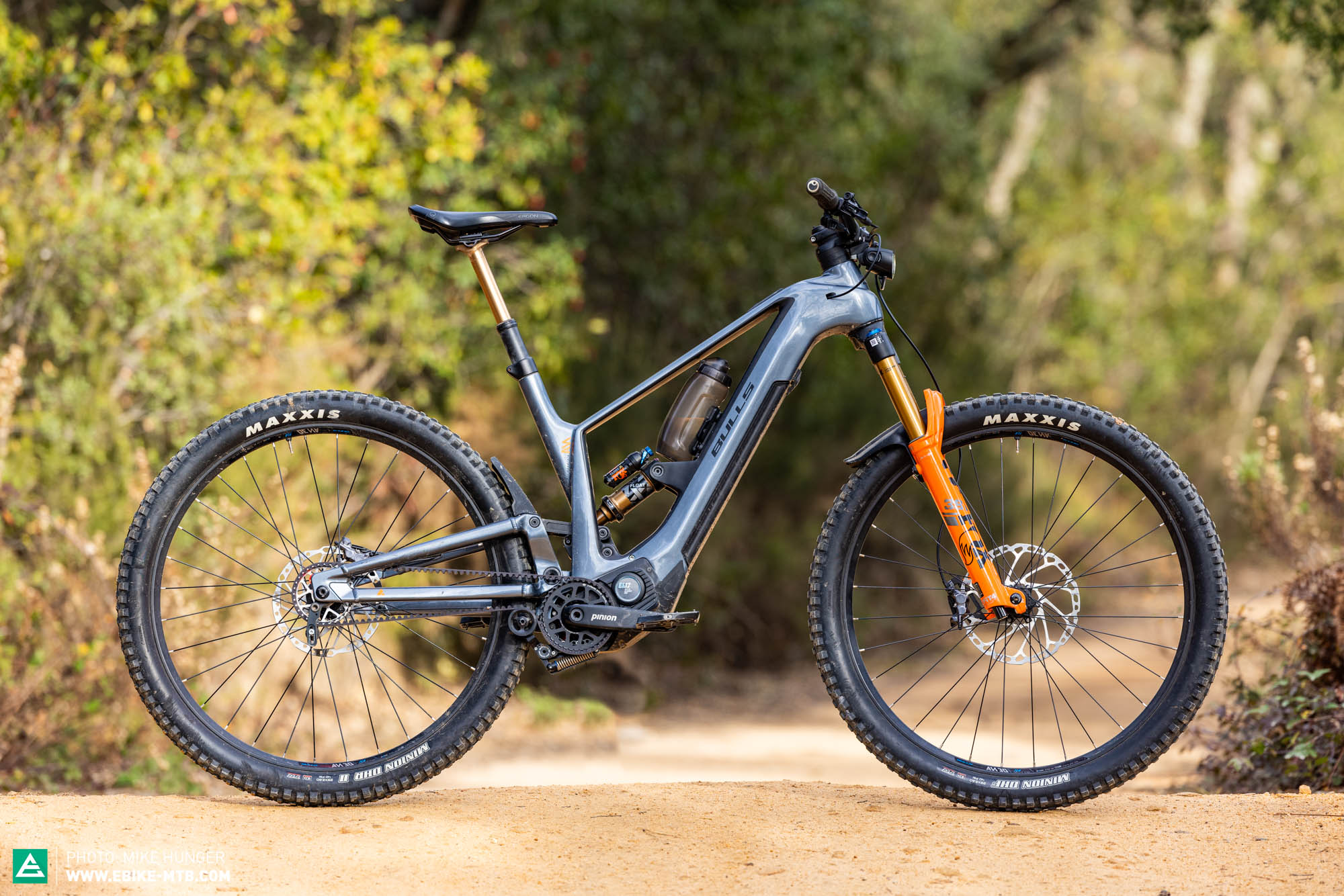
25 kg | € 7,999 | Click for review


Specialized Turbo Levo SL Expert – The best light eMTB all-rounder
The Turbo Levo SL offers a well-rounded overall package for sporty riders, which is mainly due to Specialized’s holistic approach to ebike development. Needless to say, the flawless spec and beautiful frame details play a crucial role too! On climbs, Specialized’s light eMTB might require a little more effort, but impresses with a natural riding feel. On the trail, it provides Specialized’s typical “feel-good” factor, making you feel at ease from the get-go, while putting a massive grin on your face in the process, regardless of whether you’re a beginner or an advanced rider.

18.2 kg | 9,900 € | Click for review
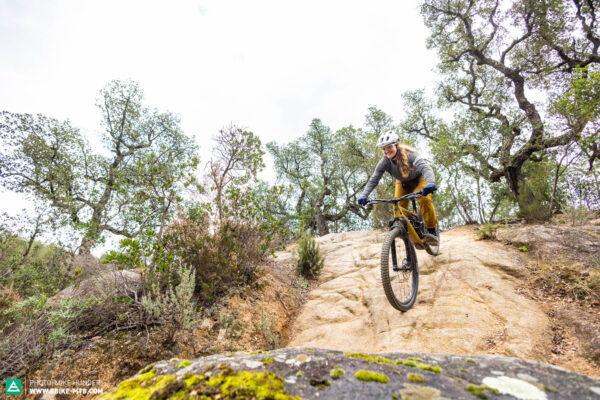

Did you enjoy this article? If so, we would be stoked if you decide to support us with a monthly contribution. By becoming a supporter of E-MOUNTAINBIKE, you will help secure a sustainable future for high-quality cycling journalism. Click here to learn more.
Words: Mike Hunger Photos: Mike Hunger, Peter Walker








